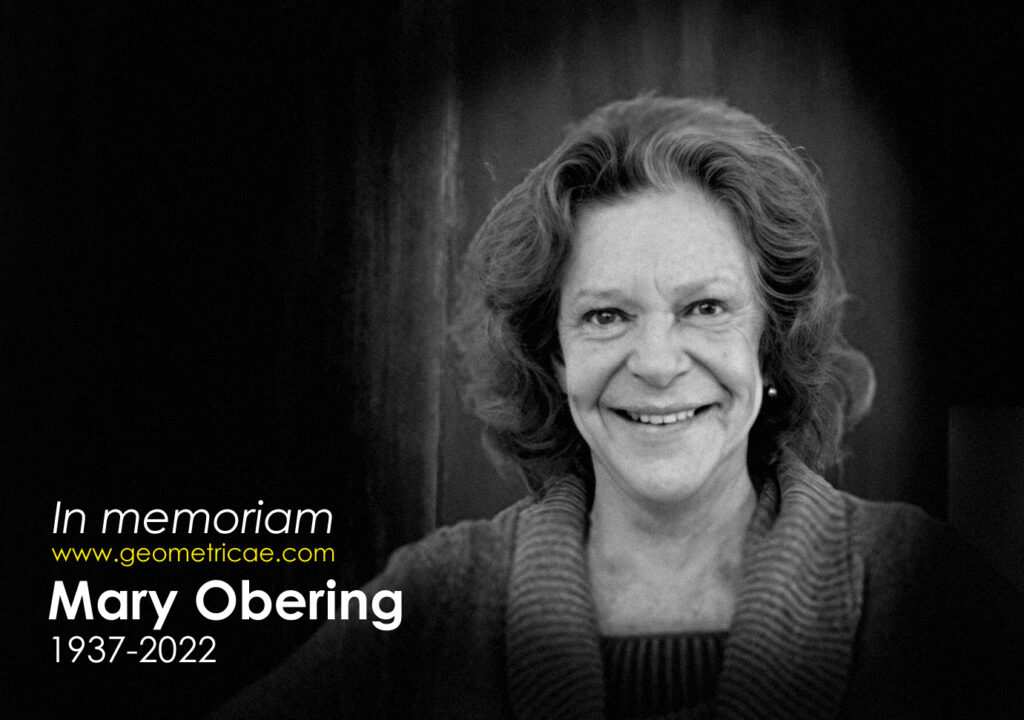 Mary Obering | Shreveport | Louisiana | 1937-2022
Mary Obering | Shreveport | Louisiana | 1937-2022
Mary Obering attended Hollins College in Virginia in the fifties and then went to graduate school at Radcliffe to study psychology. Art had always been a passion of hers, and by the time she was in her thirties, she realized that it had to be more than a mere hobby. She enrolled at the University of Denver and earned her MFA in 1971. The following summer while traveling with her daughter in Italy, she met the minimalist sculptor Carl Andre. They quickly became friends, and when she moved to New York shortly thereafter, Andre facilitated her introduction to the city’s thriving art world.
Andre curated Obering’s first-ever New York solo show, which was held at Artists Space in 1973. That show exhibited some of her earliest geometric abstractions, which were done using acrylic on canvas and enacted spare, delicate contrasts between hues.
She went on to figure in the Whitney Biennial two years later and to have shows with Julian Pretto, a dealer with a passion for the Minimalists. She also exhibited with Annina Nosei, a New York dealer known for boosting talents like Jean-Michel Basquiat and David Salle.
Obering continues to divide her time between New York and Italy, spending the spring and fall at her home in Santa Maria di Leuca and the winter and summer at her Soho loft. She has exhibited internationally at galleries and museums for forty years, and her work can be found in the collections of such major institutions as the Museum of Fine Arts (Boston), the Detroit Institute of Art, the Muse de Arte (Costa Rica), and the Whitney Museum of American Art (New York).
For a while, Obering was considered to be a somewhat obscure figure within New York art history, but in the past few years, she gained new gallery representation, and it helped to widen her audience. The now-defunct Kayne Griffin Corcoran gallery in Los Angeles added her to its roster in 2018, and Bortolami followed the year afterward.
Many of Obering’s abstractions would come to rely on materials more closely associated with art of the Renaissance than contemporary movements. She used gold leaf in her abstractions, worked in encaustic and tempera, and relied upon colors that, for some critics, seemed to recall centuries-old Italian paintings.
Obering typically paints on masonite panels with deep sides that emphasize the work’s three-dimensional presence. The painted sides demand a mobile viewer who will observe the play of light and perspectival shifts in geometry that arise from different vantage points. While Obering’s compositions are geometric and orderly, she brings a sensualist’s spirit to this rational mode. Her practice is steeped in art history, as seen in her materials—egg tempera paint she mixes herself and reflective sheets of gold leaf—which have their origins in medieval and early Renaissance altar painting. She works with a highly evocative palette that brims with references to these traditions as well as her own experiences. A vivid rectangle of midnight blue can recall the gown of the Virgin Mary in a Duccio altar panel, while a swatch of burnt sienna could be inspired by the sun-drenched architecture of southern Italy where Obering has a second home. She painstakingly builds up her paintings through repeated applications of paint, at times yielding a smooth opacity and at others more mottled and brushy textures. These richly layered surfaces fully showcase tempera’s ability to create jewel-like planes of radiant color. This precious quality of her art is further enhanced by her use of both white and yellow gold leaf to impart a striking element of material luxury.